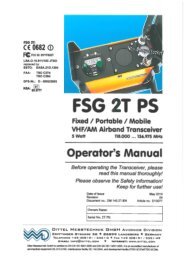EFIS-D6 Installation Guide
EFIS-D6 Installation Guide
EFIS-D6 Installation Guide
You also want an ePaper? Increase the reach of your titles
YUMPU automatically turns print PDFs into web optimized ePapers that Google loves.
<strong>EFIS</strong> Calibration and Configuration<br />
12. Wait for the message CALIBRATION COMPLETE before attempting to use the <strong>EFIS</strong>-<br />
<strong>D6</strong> or remove power. Press BACK to leave the menu.<br />
This completes the EDC-D10A calibration process. The process can be repeated as often as<br />
desired. The overall accuracy of the compass depends on the installation location (away from<br />
any ferrous materials or current carrying wires or devices), the installation alignment (aligned<br />
with the <strong>EFIS</strong>-<strong>D6</strong> in pitch, roll, and yaw), and the calibration procedure (accurately aligning the<br />
aircraft with North, East, West, and South and having the correct magnetic inclination angle<br />
loaded into the <strong>EFIS</strong>-<strong>D6</strong>). If the compass performance is not adequate for your usage, we suggest<br />
that you investigate each of these factors and try to optimize your installation for each factor.<br />
If the heading shown onscreen is off by a small, but constant amount, you can change a heading<br />
offset in the <strong>EFIS</strong>-<strong>D6</strong> which will correct this. Orient your plane in a known direction, preferably<br />
on a compass rose at the airport. Navigate to the Heading Adjustment menu by pressing SETUP<br />
> MAGADJ. Increment or decrement the value of the heading offset until the <strong>EFIS</strong>-<strong>D6</strong> heading<br />
corresponds to the direction in which your plane is pointed.<br />
<strong>EFIS</strong>-<strong>D6</strong> (INTERNAL) HEADING CALIBRATION (ON GROUND AND IN FLIGHT)<br />
NOTE: if you have installed the EDC-D10A Remote Compass Module, you do not need<br />
to perform this procedure. Skip to the next section for calibration of the remote compass.<br />
Because Dynon’s goal is to give the <strong>EFIS</strong>-<strong>D6</strong> a<br />
compass that is accurate in all attitudes, our user<br />
magnetic calibration process is more comprehensive<br />
than that for many other products. The magnetic field<br />
vector in North America is predominantly vertical;<br />
this requires that any complete calibration maneuver<br />
bank the aircraft significantly in order to accurately<br />
map out the unique magnetic signature of your plane<br />
in this three-dimensional field. Therefore, a large<br />
It is crucial that compass heading<br />
calibration be done after the unit is<br />
completely integrated into your<br />
panel. If the unit is calibrated away<br />
from the panel and then inserted at<br />
a later time, it will be improperly<br />
biased by the unique magnetic field<br />
characteristics of your plane.<br />
quantity of data needs to be recorded in a variety of attitudes. Simpler calibration processes do<br />
not perform these steps and suffer by being accurate only at level attitudes. When properly<br />
completed, a magnetic calibration of this complexity will produce a compass that is accurate<br />
during banked maneuvers. Note that the EDC-D10A remote compass calibration process is not<br />
as complex because it is assumed that you have mounted it in a more magnetically clean<br />
environment. Three dimensional calibration has already been done on the EDC-D10A at the<br />
factory.<br />
Before proceeding with the calibration, ensure that you have determined and entered the<br />
magnetic inclination (dip angle) and intensity as described above.<br />
Performing the calibration<br />
Perform the first portion of the heading calibration on the ground in an area where you can<br />
accurately determine magnetic North such as on a compass rose. You must also have enough<br />
room to perform a 540 turn on the ground as described below. Turn the <strong>EFIS</strong>-<strong>D6</strong> on and let it<br />
warm up for 10-15 minutes before proceeding. Turn all instruments on that you would normally<br />
be operating during a flight, including the engine.<br />
4-4 <strong>EFIS</strong>-<strong>D6</strong> <strong>Installation</strong> <strong>Guide</strong>
















